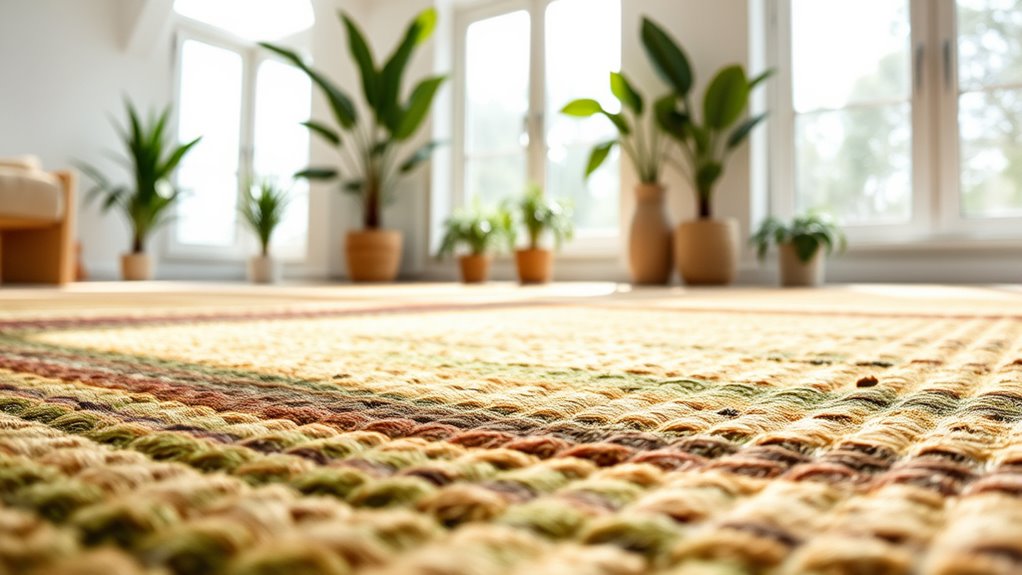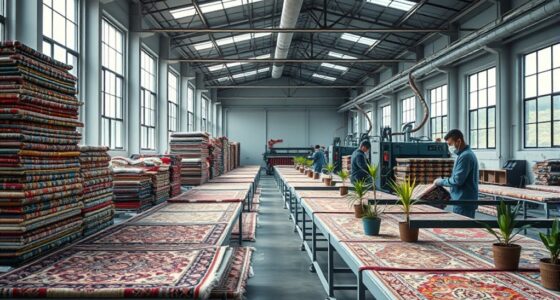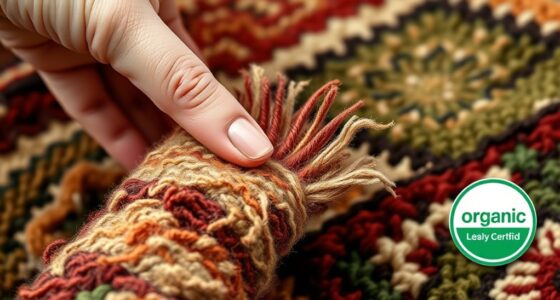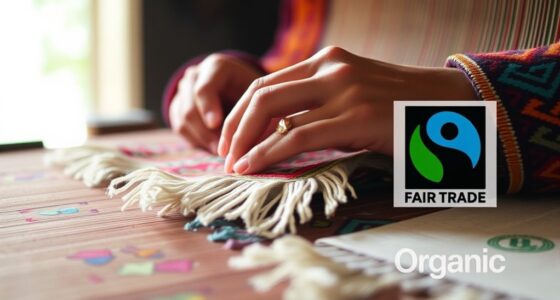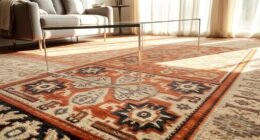The future of sustainable flooring focuses on eco-friendly rug materials that blend style, functionality, and environmental responsibility. You’ll see more options like recycled polyester, wool, jute, and sisal, all designed to reduce waste and lower your carbon footprint. Biodegradable finishes and natural coatings help rugs last longer while breaking down safely over time. As these trends grow, you’ll discover how sustainable choices can transform your space and support a greener future.
Key Takeaways
- Growing availability of stylish, eco-friendly rugs made from recyclable fibers like recycled polyester, wool, jute, and sisal.
- Increased use of biodegradable finishes and plant-based coatings to extend rug lifespan sustainably.
- Integration of eco-conscious materials into mainstream interior design, reflecting lifestyle and environmental values.
- Innovations in sustainable manufacturing techniques leading to more diverse, functional, and environmentally responsible rug options.
- Rising consumer demand for green flooring solutions driving manufacturers to prioritize sustainability in future rug designs.

Are you curious about how sustainable flooring is transforming interior design? The shift toward eco-friendly materials isn’t just a fleeting trend; it’s a fundamental change driven by a growing awareness of environmental impact. When exploring sustainable flooring options, you’ll notice an increasing emphasis on using recyclable fibers and biodegradable finishes. These innovations allow you to enjoy stylish, comfortable spaces while reducing your carbon footprint.
Recyclable fibers are at the forefront of eco-friendly rug materials. Unlike traditional synthetic fibers that often end up in landfills, recyclable fibers can be reprocessed and reused, minimizing waste. Materials such as recycled polyester, wool, jute, and sisal are gaining popularity because they come from renewable sources or can be repurposed after their initial use. Wool, in particular, offers natural insulation and durability, making it both sustainable and practical. Jute and sisal are plant-based fibers that grow quickly and require fewer resources, making them a responsible choice for eco-conscious consumers. When you opt for rugs made from recyclable fibers, you actively participate in closing the loop, reducing waste, and supporting a circular economy. Additionally, fiber recyclability ensures that materials can be reintroduced into the production cycle, further supporting sustainability.
Recyclable fibers like wool, jute, and sisal promote sustainability and reduce waste in eco-friendly rugs.
Equally important are biodegradable finishes, which enhance the durability and aesthetic appeal of sustainable rugs without compromising environmental integrity. These finishes are designed to break down naturally over time, reducing the risk of pollution and long-term waste. For example, natural oils or plant-based coatings can protect fibers from moisture and wear while remaining environmentally friendly. When you choose rugs with biodegradable finishes, you’re not only extending the lifespan of your flooring but also ensuring that, at the end of their life cycle, they won’t contribute to landfill problems. This approach aligns with the broader goal of reducing chemical use and pollution, making your interior space healthier for you and the planet.
Incorporating sustainable flooring materials like those with recyclable fibers and biodegradable finishes isn’t just a trend—it’s a lifestyle choice that reflects your values. As technology advances and more manufacturers prioritize eco-conscious practices, you’ll find an increasing variety of options that combine style, functionality, and environmental responsibility. Whether you’re renovating a single room or designing a whole home, selecting eco-friendly rugs not only elevates your interior aesthetic but also supports a more sustainable future. By making informed choices today, you contribute to reducing waste and conserving resources, proving that beautiful design and environmental stewardship can go hand in hand.
Frequently Asked Questions
How Do Eco-Friendly Rugs Compare in Durability to Traditional Options?
Eco-friendly rugs often match or even surpass traditional options in durability, thanks to innovative materials and manufacturing techniques. Durability comparisons show that eco-friendly rugs resist wear, stains, and fading just as well as, if not better than, conventional rugs. Material longevity improves with natural fibers like jute, sisal, and recycled materials that age gracefully, maintaining their beauty over time. You can enjoy eco-conscious choices that stand the test of time without sacrificing quality.
Are There Any Health Risks Associated With Natural Rug Materials?
Natural rug materials generally pose fewer health risks, especially if you’re sensitive to chemicals or allergens. You won’t have to worry as much about chemical sensitivities or allergen concerns, since these rugs are usually free from synthetic dyes and harsh chemicals. However, always check for untreated, organic options and verify proper ventilation during installation. This way, you minimize any potential health risks and enjoy a safe, eco-friendly rug in your space.
Can Sustainable Rugs Be Customized for Specific Interior Designs?
Did you know that 78% of homeowners want personalized interior designs? Sustainable rugs are highly customizable, allowing you to select colors, patterns, and materials that match your style. With extensive customization options, you gain greater design flexibility, ensuring your eco-friendly rug complements your space perfectly. This means you can create a unique, sustainable focal point that aligns with your aesthetic preferences without compromising environmental values.
What Is the Cost Difference Between Eco-Friendly and Conventional Rugs?
You’ll find that eco-friendly rugs often have a higher cost comparison to conventional rugs, mainly due to sustainable materials and ethical manufacturing. However, there’s price variability depending on factors like material quality and brand. While you may pay more upfront, investing in eco-friendly rugs supports environmental goals and often guarantees durability. So, consider the long-term benefits and choose a rug that aligns with your values and budget.
How Do Maintenance Requirements Differ for Sustainable Flooring Materials?
Sure, maintaining sustainable flooring might seem like a chore, but you’ll be surprised. You’ll find that eco-friendly rugs often require less frequent cleaning because of their stain-resistant properties, making life easier. Plus, they’re designed to withstand wear and tear better, so you won’t need to scrub as often. All that means you get to enjoy a cleaner home with less effort—who knew sustainability could be so low-maintenance?
Conclusion
So, as you roll out these eco-friendly rugs, imagine yourself dancing barefoot on a lush, forest-grown carpet, all while saving the planet one stylish step at a time. Who knew that choosing sustainable flooring could turn your living room into a green paradise—or at least make your friends envy your eco-chic taste? Embrace the trends, and soon your home will be the envy of Mother Nature herself, one sustainable fiber at a time.
